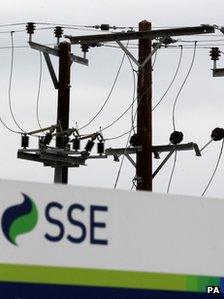No escape from pricy energy
- Published
- comments

There is a stark message in today's half-year results from the power giant SSE and a report on the impact for consumers of upgrading energy and water infrastructure.
Which is, that it is impossible to duck the cruel fact that these basics of life will become more expensive for as far as the eye can see.
That is because (sorry to resort to truisms) resources are becoming scarcer, relative to increasing global populations and because - many would argue - there has been too little investment in the UK in recent years in modernising the pipes and securing new sources of energy.
But SSE's figures and the NAO's analysis do not lead to a fatalistic conclusion that we should just grit our teeth and simply fork out the extra money, that there is no scope for a debate about any of this.
Because if there is a limit to our ability to stem these rising costs, we do have the ability to choose how we pay and who pays.
For the NAO, the big issue is whether the government needs to be doing more to plan ahead to limit the burden for those on lower incomes, who have suffered the sharpest squeeze on living standards in recent years.
Meanwhile the implication of SSE's results is that it cannot afford to alienate the City and investors if it is to be able to secure necessary investment in power and distribution.
That is the context for seeing its dividend increase of 3.2%, which is above RPI inflation (either 2.6% or 1.9%, depending on whether you prefer the old or new measure), and a pledge to deliver dividend rises above inflation for as far as the eye can see.
Now some may argue that it's unfair that this income for shareholders is protected at a time when SSE is putting up energy tariffs by 8.2%.
But SSE would say that the 3.2% dividend rise is the minimum it can pay to demonstrate to its owners that it is a viable business for the long term - which matters given that it is investing to improve its network and operations at a rate of £804m in just the six months, and it has net debts that rose by £450m to £7.8bn.
But that is not the whole story.
What is particularly striking is that it is SSE's regulated businesses, in transmission and distribution, where it has little discretion over pricing, which enjoyed big profit increases - whereas it made a substantial loss in the supply of energy.
It was in the red to the tune of £115.4m from retailing energy to millions of customers.
But its operating profit from electricity distribution was £232m, up 9%, while electricity transmission saw profits increase 39% to £67.6m.
And the operating profit from running a gas network was almost 13% higher at £138m.
These increases in the returns from regulated businesses beg a few questions.
Are they greater than necessary to secure necessary investment in the network? Or to put it another way, has the regulator mucked this up
Also, does SSE exploit the safe and steady profits it earns from transmission and distribution to limit tariff rises in its supply business, thus easing the pain for customers, or are these reliable long-term returns irrelevant to its retail pricing decisions?
There are two ways of looking at that question.
First, whether there is any kind of cross subsidy from distribution/transmission to supply.
The recent price hike would suggest there is not.
Second, whether SSE invests more in power generation and makes bigger long-term commitments to buy gas precisely because it has the financial muscle provided by robust infrastructure businesses.
Or to put it another way, is the energy conglomerate model of SSE, and its rivals (although they are all a bit different), a guarantor of value for money for customers or a source of obfuscation and confusion in the market?